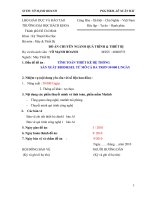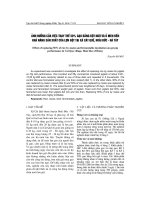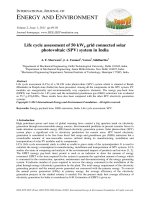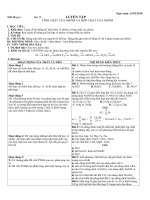50 Discrete Math CS 23022
Bạn đang xem bản rút gọn của tài liệu. Xem và tải ngay bản đầy đủ của tài liệu tại đây (498.18 KB, 81 trang )
Discrete Math
CS 23022
Prof. Johnnie Baker
Module
Induction
1
Acknowledgement
Most of these slides were either created by
Professor Bart Selman at Cornell University or
else are modifications of his slides
2
What’s is Induction About?
Many statements assert that a property is an universal true – i.e., all the
elements of the universe exhibit that property;
Examples:
1. For every
positive integer n: n! ≤ nn
2. For every set with n elements, the cardinality of its power set is 2n.
Induction is one of the most important techniques for proving statements
about universal properties.
3
We know that:
1.
2.
We can reach the first rung of this ladder;
If we can reach a particular rung of the ladder,
then we can reach the next rung of the ladder.
Can we reach every step of this infinite ladder?
Yes, using Mathematical Induction which is
a rule of inference that tells us:
P(1)
∀ k (P(k) → P(k+1))
--------------------------
∴ ∀ n (P(n)
Principle of
Mathematical Induction
Hypothesis: P(n) is true for all
integers n ≥ b
To prove that P(n) is true for all integers n ≥ b (*), where P(n) is a
propositional function, follow the steps:
Basic Step or Base Case: Verify that P(b) is true;
Inductive Hypothesis: assume P(k) is true for some k ≥ b;
Inductive Step: Show that the conditional statement P(k) →P(k+1) is true
for all integers k ≥ b. This can be done by showing that under the
inductive hypothesis that P(k) is true, P(k+1) must also be true.
(*) quite often b=1, but b can be any integer number.
5
Writing a Proof by Induction
1. State the hypothesis
P(n) is true for all
very clearly:
integers n≥ b – state the property P in English
2. Identify the the base case
P(b) holds because …
3. Inductive Hypothesis
Assume P(k)
4. Inductive Step - Assuming the inductive hypothesis P(k), prove that P(k+1)
holds; i.e.,
P(k) → P(k+1)
Conclusion
By induction we have shown that P(k) holds for all k ≥ b (b is what was used
for the base case).
6
Mathematical Induction
Prove a base case (n=1)
Use induction to prove that the sum of the first n odd integers
is n2.
Prove
P(k)→P(k+1)
What’s the hypothesis?
1 – Hypothesis: P(n) – sum of first n odd integers = n 2.
2 - Base case (n=1): the sum of the first 1 odd integer is 1 2.
Since 1 = 12
3 - Assume P(k): the sum of the first k odd ints is k2.
1 + 3 + … + (2k - 1) = k2
Inductive
hypothesi
s
4 – Inductive Step: show that ∀(k) P(k) → P(k+1), assuming P(k).
How?
By inductive
P(k+1)= 1 + 3 + … + (2k-1) + (2k+1) = k2 + (2k + 1)
= (k+1)2
p(k)
QED
hypothesis
7
Mathematical Induction
Prove a base case (n=?)
Prove P(k)→P(k+1)
Use induction to prove that the 1 + 2 + 22 + … + 2n = 2n+1 - 1 for all
non-negative integers n.
1 – Hypothesis?
P(n) = 1 + 2 + 22 + … + 2n = 2 n+1 – 1
for all non-negative integers n.
2 - Base case?
n = 0 10 = 21-1.
3 – Inductive Hypothesis
Assume P(k) = 1 + 2 + 22 + … + 2k = 2 k+1 – 1
not n=1! The base case
can be negative, zero,
or positive
Inductive
hypothesi
s
8
Mathematical Induction
4 – Inductive Step: show that ∀(k) P(k) → P(k+1), assuming P(k).
How?
P(k+1)= 1 + 2 + 22 + … + 2k+ 2k+1 = (2k+1 – 1) + 2k+1
p(k)
= 2 2k+1 - 1
By inductive
hypothesis
P(k+1) = 2k+2 - 1
= 2(k+1)+1 - 1
QED
9
Mathematical Induction
Prove that 1⋅ 1! + 2⋅ 2! + … + n⋅ n! = (n+1)! - 1,
∀ positive integers
1 – Hypothesis P(n) = 1⋅ 1! + 2⋅ 2! + … + n⋅ n! = (n+1)! - 1, ∀ positive integers
2 - Base case (n=1): 1⋅ 1! = (1+1)! - 1?
1⋅ 1! = 1 and 2! - 1 = 1
Inductive
hypothesi
3 - Assume P(k): 1⋅ 1! + 2⋅ 2! + … + k⋅ k! = (k+1)! - 1
s
4 – Inductive Step - show that ∀(k) P(k) → P(k+1), assuming P(k).
I.e, prove that 1⋅ 1! + … + k⋅ k! + (k+1)(k+1)! = (k+2)! – 1, assuming P(k)
1⋅ 1! + … + k⋅ k! + (k+1)(k+1)! = (k+1)! - 1 + (k+1)(k+1)!
= (1 + (k+1))(k+1)! - 1
= (k+2)(k+1)! - 1
= (k+2)! - 1
QED
Mathematical Induction
Prove that a set with n elements has 2n subsets.
1-Hypothesis: set with n elements has 2n subsets
2- Base case (n=0): S=ø, P(S) = {ø} and |P(S)| = 1 = 20
3- Inductive Hypothesis - P(k): given |S| = k, |P(S)| = 2
k
Inductive
hypothesi
s
4- Inductive Step: ∀(k) P(k) → P(k+1), assuming P(k). i.e,
Prove that if |T| = k+1, then |P(T)| = 2k+1, given that P(k)=2k
11
Inductive Step: Prove that if |T| = k+1, then |P(T)| = 2k+1 assuming
P(k) is true.
T = S U {a} for some S ⊂ T with |S| = k, and a ∈ T
How to obtain the subsets of T?
For each subset X of S there are exactly two subsets of T, namely X and X U {a}
Generating subsets of a set T with k+1 elements
from a set S with K elements
Because there are 2k subsets of S (inductive hypothesis), there are 2 × 2k subsets of T.
QED
Deficient Tiling
A 2n x 2n sized grid is deficient if all but one cell is tiled.
2n
2n
CS173
Mathematical Induction - a cool example
Hypothesis:
P(n) - We want to show that all 2n x 2n sized deficient grids can
be tiled with right triominoes, which are pieces that cover
three squares at a time, like this:
14
Mathematical Induction - a cool example
Base Case:
P(1) - Is it true for 21 x 21 grids?
YES
15
Mathematical Induction - a cool example
Inductive Hypothesis:
We can tile a 2k x 2k deficient board using our designer tiles.
Inductive Step:
Use this to prove that we can tile a 2k+1 x 2k+1 deficient board
using our designer tiles.
16
2k
2k
2k
?
?
2k+1
2k
OK!!
(by IH)
?
2k
2k
2k
OK!!
(by IH)
OK!!
(by IH)
2k+1
2k
OK!!
(by IH)
OK!!
(by IH)
So, we can tile a 2k x 2k deficient board using our designer tiles.
What does this mean for 22k mod 3?
= 1 (also do
direct proof by induction)
Mathematical Induction - why does it work?
Definition:
A set S is “well-ordered” if every non-empty subset of S has a least
element.
Given (we take as an axiom): the set of natural numbers (N) is wellordered.
Is the set of integers (Z) well ordered?
No.
{x∈Z:x<0}
has no least
element.
21
Mathematical Induction - why does it work?
Is the set of non-negative reals (R) well ordered?
No.
{x∈R:x>1}
has no least
element.
22
Mathematical Induction - why does it work?
Proof of Mathematical Induction:
We prove that
(P(0) ∧ (∀ k P(k) → P(k+1))) → (∀ n P(n))
Assume
P(0)
∀k P(k) → P(k+1)
¬∀n P(n)
Proof by
contradiction.
∃ n ¬P(n)
23
Mathematical Induction - why does it work?
Assume
P(0)
∀n P(n) → P(n+1)
¬∀n P(n)
Let S = { n : ¬P(n) }
∃ n ¬P(n)
Since N is well ordered, S has a least
element. Call it k.
What do we know?
P(k) is false because it’s in S.
k ≠ 0 because P(0) is true.
P(k-1) is true because P(k) is the least element in S.
But by (2), P(k-1) → P(k). Contradicts P(k-1)
true, P(k) false.
Done.
24
Strong Induction
1. State the hypothesis
P(n) is true for all
very clearly:
integers n≥ b – state the property P is English
2. Identify the the base case
P(b) holds because …
3. Inductive Hypothesis
(P(b) ∧ P(b+1) ∧ … ∧ P(k)
4 . Inductive Step - Assuming P(k) is true for all positive integers not
exceeding k (inductive hypothesis), prove that P(k+1) holds; i.e.,
(P(b) ∧P(b+1) ∧… ∧P(k) → P(k+1)
25









